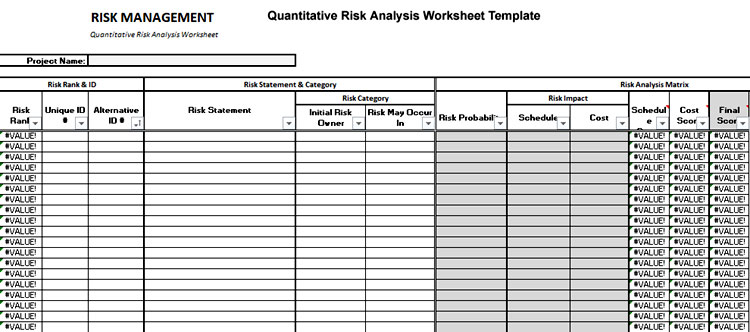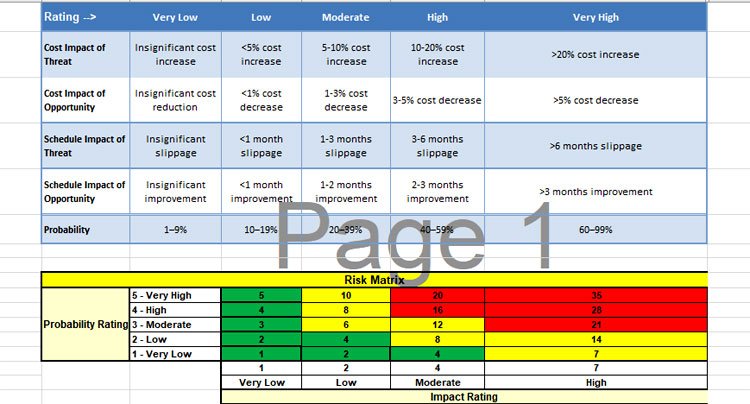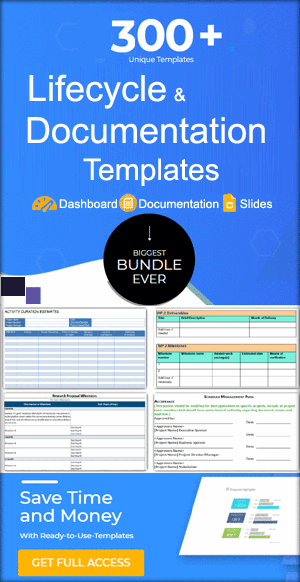Project Risk Management Plan Template Excel

Every business small or big has always some risks associated with it, and it is very necessary to pinpoint and resolve risks on time. Business organizations and companies often have a proper well-maintained system to address issues and risks.
One of the most helpful tools, they use is Project Risk Management Plan Template. These templates help the managers to address and resolve the risks on time before they make any serious damage to the projects’ health.
The risk management plan is often an important part of the project charter which is the final and authenticated plan. Unlike other project-related plans, the project risk plan usually stays the same throughout the life cycle of the project.
Which Processes are Involved in Project Risk Management?
- Planning risk management
- Isolating the risks
- Performing qualitative risk analysis
- Performing quantitative risk analysis
- Monitor and plan risk responses
- Execute the risk responses
- Monitor and examine risks
In this article, we will see what the Project Risk Management Plan Template is and why is it of great significance. We will also shed some light on its format and important components.
Project Risk Management Plan Template in Excel is a valuable tool designed to systematically identify, assess, and mitigate potential risks that may arise during the course of a project.
This document serves as a structured framework for project managers and teams to proactively address uncertainties, ensuring a higher likelihood of successful project outcomes.
The template typically comprises various sections, such as risk identification, risk assessment, risk response planning, and risk monitoring and control.
An Overview of the Project Risk Management Plan (Dashboard)
A Project risk management plan template basically is a tool that is used by project managers to eradicate risks and analyze their effects. Moreover, also aids in planning strategic solutions to the identifier issues and problems. There is a need to act factually when a risk is identified.
As if you overlook or ignore it this could cause serious consequences for the health of your projects and tasks. The development of the project can quickly go south when there is a delay in managing the risks.
Therefore, it is very important to have a proper system in place to monitor and resolve risks for the battement of your project.
Risk Management | Project Portfolio Dashboard



Once the risk is identified and seen to there is a very important last step to this process which is to monitor it for a certain period. This practice makes sure the risk does not have any aftereffects or it does not bounce back and make any serious damage.
There are basically three steps in a risk management plan identify the risk, assess the risk, respond to the risk, and finally monitor the risk.
Available Template To Download
Issue Management Log

Quantitative Risk Analysis Worksheet Template

Impact and Probability Metrics

Format of Risk Management Plan
Risks are the understood and crucial components of any project. Managing your risks on time with a proper strategic plan is imperative and very important without any doubt. There is always a chance that the risks are linked and come in small groups.
So, it is very important for you to talk them through, assess them, and resolve them without wasting any time. Furthermore, it is very important to discuss your risks with your team and your stakeholders as well. As it is necessary that they are aware of all the potential and identified risks.
Now let us have a look at how a Project risk management plan template is crafted and how it works.
- First, the identified risks are documented and sent to the project manager for further assessment.
- In a project risk management template, the first place is for the project name and a small description in the project overview section if needed.
- Then you document the project id if there is any.
- You must also document and identify the sponsor and stakeholders in the template.
- After that, there is the place for risk description which includes importance, impact, detectability, and probability.
- The trigger events and risk trigger indicators are also an important part of the risk planning and management template.
- Further in the template, there is space for putting down the risk response and its comprehensive but short description.
- Another important part of this template is the contingency plan.
- Lastly, there is a need to document the dates of the issue and the dates of review as well.
Risk Issues Management Form
| Column | Instructions For Completing This Document |
| Complete the Project Name, Project Manager Name, and Project Description fields. | |
| For each issue identified, complete the following: | |
| A | ID: A unique ID number is used to identify the issue in the issue tracking log. |
| B | Current Status: Valid options include the following:
Open: The issue is currently open but has not yet been addressed. Some other potential options include: |
| C | Priority: Valid options include the following:
Critical: The issue will stop project progress if not resolved. |
| D | Issue Description: Describe the issue. |
| E | Assigned to Owner: |
| F | Expected Resolution Date: |
| G | Escalation Required (Y/N): |
| H | Impact Summary: |
| I | Action Steps: |
| J | Issue Type: Identify the issue type:
Informational: The issue was generated and logged in response to a request for information external to the immediate project/project team. |
| K | Date Identified: Record the date the issue was identified. |
| L | Associated ID(s): Identify the project ID of any associated milestones that may be impacted by the issue or that the issue is dependent upon for resolution. |
| M | Entered By: Name the individual who first identified the issue. |
| N | Actual Resolution Date: Record the date the issue was resolved. |
| O | Final Resolution & Rationale: Describe the final resolution and rationale of the issue. |
| Column | Instructions For Changing the Contents of Drop-Down Menus |
| B, C G, J | Highlight the cell you want to edit.
From the File, the menu clicks “Data” -> “Validation” and changes the content of the source field. |
| Column | Instructions For Filtering Data |
| Any | Highlight the header of the cell you wish to filter data on.
From the file menu click “Date” -> “Filter” ->”Auto Filter.” Select your filter criteria from the drop-down menu that appears on your header cell. |
Risk Mitigation Plan Template
A risk mitigation plan is basically the name of planning strategies and processes to enhance project productivity and reduce the probability of risks.
It mainly is strategic and smart planning of mitigating risks for the battement and successful completion of the project. The risk mitigation process mainly includes tracking, identifying, and evaluating the risk.
The well-known four mitigation strategies are risk prevention, recognition, transference, restriction, and restraints.
The risk can be of two different categories they can be internal or external. Thus, there is a need to address and make the mitigation plan according to the type of risk you are working on.
Risk Management Matrix Template
The risk managing matrix template is a helping hand in the process of risk management and planning. as it mainly is made to help in the assessment and evaluation of the risk.
The matrix highlights the severity and probability of occurring the damage by risks. In this tool, the risk is evaluated based on its impact on the project. Therefore, this comes in very handy and serves as a helping tool in the risk management process.
According to the impact, the risks fall into different categories in the risk management matrix. This helps in identifying them and making a strategic plan for eliminating them in accordance with the data from the risk matrix.
This way you can easily assess the level and kind of risk you are up against. The given data will allow you to see what level and what kind of plan you need to implement for a specific intensity of risk.
The risk matrix mainly often uses the color-coding system to evaluate the risks. The legends of the matrix will allow you to understand how serious and complicated a risk is. In the risk assessment matrix, there are two main things one is the severity and the other is the likelihood.
The severity has different color coding the likelihood has different. Consequently, the risks once identified then assessed according to their rank in the matrix and further forward to make plans to resolve the issues as soon as possible.
Conclusion
We have seen that risk management is undoubtedly a vital part of the process of project management. So, it is essential that a proper Project risk management plan template is in place on hand to use when needed.
It is also recommended to address and resolve the risk as soon as possible to avoid any serious damage to your project.
template aids in listing and categorizing potential risks that could affect project objectives, timelines, or resource planning. These risks may include external factors like market volatility, regulatory changes, or weather conditions, as well as internal factors like resource constraints, skill gaps, or technology limitations.
The template also encourages the identification of both negative risks (threats) and positive risks (opportunities) that could impact the project.




Aww! That happens when you’re a regular customer and when the owner knows you’re dedicated towards something.
From where we can find these???
Hi Tiny Gilham Thanks for your visit. please check your inbox!
Hi, could you kindly send me the templates.
Much appreciated.
Hi Tiny,
Would it be possible to get a copy of the templates?
Thank you!
Harry
Hi
Where can I find these templates?
Hi, John Thanks for visiting us! I have just sent you an email along with the project risk management excel file. Hope you find it helpful.
Regards
Team PMT
HI, AM INTERESTED IN THIS TEMPLATE
Hi ALFRED OGONDA Please check your inbox. Hope you find it helpful.
I am interested in the above mentioned templates.
Matthew Apping please check your inbox!
I am very interested in these templates. They would be greatly appreciated.
I’m interested in all templates!
I’m interested in these templates as well.
Hi los andez please check your inbox!
I’m interested in these templates as well.
Hi Harsimar kaur Makkar Thanks for your visit. Please check your inbox!
I am interested in templates too. I’ve given my email.
Marck check your inbox!
Please Share The Templates
I am interested in this Risk management templates, can I have?
Dear madam or sir,
Could you send that template to me too, please?
Best,
Joerg Rosenbohm
Am very interested in all of the above templates – how can I get access the them? Many thanks
Very interested in the above templates – could you please send? Thank you
Can you please share the templates? TIA
Are these templates free? Could you share?
Hi:
Great article about Risk Management. To what extent will it be possible for you to share these templates? Regards
Manuel
I am interested in this template . Thanks!
Could I please get the templates? Thanks!
I am interested in these templates too
Hi I am interested in this template.
Hey, can you pelase share with me the templates!
Great article about Risk Management. To what extent will it be possible for you to share these templates? Regards Reinhold
Great article about Risk Management. Could I please get the templates? Thank you.
Hi, can you send me this template?
Hi, would love the templates for these.
Hi Ellie S
Please check your inbox, hope you find it helpful.
Hi, I’m interested in these templates.
HI Tian Wang, Thanks for visiting us. Please check your inbox!
Hi, Could you share the template
Thank you in advance.
Hi Ittikorn
Please check your inbox hope you find it helpful.
Can you share me all the templates?
Looks like a helpful template, can I have a copy of that please?
Thank you for your content.
Could you please send me the related template?
Thanks a lot!
Hi, Could you share the template
Thank you
Hi Team PMT,
The article has been quite insightful, will it be possible for you to share the template.
Thanks.
Hi Where can I find these for download?
Hi thank you for this amazing article. These templates would be perfect for a project I am working on. can you please share them with me. It would be greatly appreciated!
Very interesting, could you share the template with me?
Hello, I really like your templante, can you share with me to me?
Tks!
Hello, can you share these templates with me please? Thank you.
Can you share the template please
its very fine, can you share the template please? Thank you!
I am interested in the above mentioned templates too.Thank you!
Excellent insight and advice. Please send me the templates.
Please send me the templates.
hello, please share the risk management template